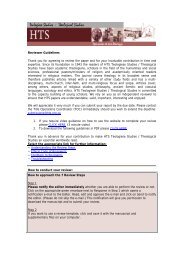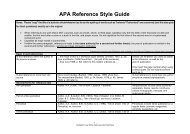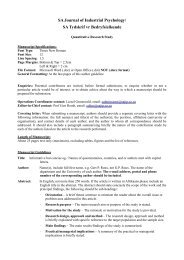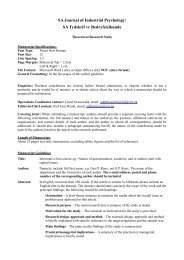Guideline for articles (Qualitative research)
Guideline for articles (Qualitative research)
Guideline for articles (Qualitative research)
You also want an ePaper? Increase the reach of your titles
YUMPU automatically turns print PDFs into web optimized ePapers that Google loves.
Key words:<br />
Synopsis:<br />
· Practical/managerial implications – A summary of the practical or managerial<br />
implications is briefly stated.<br />
· Contribution/value-add – A concluding statement indicates the contribution or value-add<br />
of the study in addressing gaps or contradictions in the literature.<br />
Use five [5] words not already included in the title, separated by a semi-colon. Refer to the<br />
discipline; sub-discipline; field; theme; <strong>research</strong> design; context<br />
Afrikaans <strong>articles</strong> (or <strong>articles</strong> in any other official SA language) must also have a synopsis of<br />
the article of between 500-600 words in English (the entire synopsis appears in italics).<br />
We also ask that you upload a brief biographical note (entered into the ‘Bio statement’ box during the<br />
submission process). This note will appear online in our ‘About the Author’ section should your article be<br />
published with us.<br />
Manuscript Contents<br />
The manuscript contains five sections, namely the introduction, <strong>research</strong> design, results, discussion and the<br />
references. All these first-level headings appear in bold capital letters and are centered.<br />
INTRODUCTION (first-level heading)<br />
The introductory section normally contains the following seven elements; headings are indicated in [brackets]:<br />
(1) [Key focus of the study] A thought-provoking introductory statement on the broad<br />
theme or topic of the <strong>research</strong> (why should I even bother to read further);<br />
(2) [Background to the study] Providing the background or the context to the study<br />
(explaining the role of other relevant key variables in this study);<br />
(3) [Research purpose] Indicate the most important controversies, gaps and<br />
inconsistencies in the literature to be addressed by this study;<br />
(4) [Trends from the <strong>research</strong> literature] Cite the most important published studies<br />
previously conducted on this topic or that has any relevance to this study (provide a<br />
high-level synopsis of the <strong>research</strong> literature on this topic);<br />
(5) In view of the above (in 4) state the core <strong>research</strong> problem and specific <strong>research</strong><br />
objectives that will be addressed in this study;<br />
(6) [The potential value-add of the study] Explanation of the study’s academic<br />
(theoretical & methodological) or practical merit and/or importance (provide the<br />
value-add and/or rationale <strong>for</strong> the study); and<br />
(7) [What will follow] Provide the reader with an outline of what to expect in the rest of<br />
the article.<br />
The first-level heading is INTRODUCTION. However, second-level headings may be used in this<br />
introductory section. These subheadings are flush with the margin, and are typed in lower case; bold starting<br />
with a capital letter. The INTRODUCTION section consists of an introduction to the article and a literature<br />
review.<br />
If lists of bullet points are presented, they should be in the following <strong>for</strong>mat:<br />
• Longevity. How long individuals live.<br />
• Prognosis. How well an individual responds to challenges of disease or trauma.<br />
• Mental health. General level of mental functioning



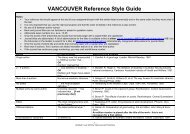
![Reference Style Guide [17-09-2008 Tdv].pdf](https://img.yumpu.com/42195443/1/184x260/reference-style-guide-17-09-2008-tdvpdf.jpg?quality=85)
